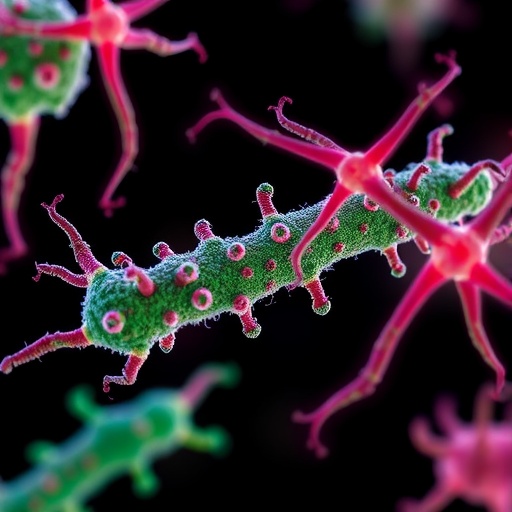In a groundbreaking discovery that could revolutionize our understanding of microbial survival in extreme environments, researchers at the University of Houston have revealed that a rare bacterium, Tersicoccus phoenicis, has the remarkable ability to evade detection within NASA spacecraft assembly clean rooms by entering a dormant state. This finding, detailed as a critical advancement in planetary protection and sterilization science, underscores the extraordinary adaptability of microorganisms even under the most stringent conditions designed to maintain sterile space exploration environments.
Tersicoccus phoenicis, a novel bacterium identified over a decade ago in high-grade clean rooms located in Florida and French Guiana, has long puzzled scientists due to its persistence in environments that undergo rigorous sterilization protocols aimed at eliminating microbial contamination. These clean rooms serve as vital hubs where spacecraft are constructed and meticulously cleaned to avoid carrying Earth-bound microbes to other planets. The mere presence of T. phoenicis in such facilities raises profound questions about the limits of current sterilization methods and the resilience of microbial life.
Led by Madhan Tirumalai, a research assistant professor in the University of Houston’s Department of Biology and Biochemistry, the investigative team including experts William Widger, Sahar Ali, and George E. Fox explored the survival mechanisms that enable T. phoenicis to withstand the harsh, nutrient-deprived conditions of spacecraft assembly clean rooms. Their research revealed that the bacterium enters a state of dormancy, significantly reducing its metabolic activity to effectively “play dead,” a survival strategy that allows it to escape routine detection and disinfection measures.
Dormancy, characterized by an extreme reduction in cellular function and halt in reproduction, is a well-documented survival tactic among various bacterial species, particularly within the actinobacteria phylum to which T. phoenicis belongs. This phylum includes notorious pathogens such as Mycobacterium tuberculosis, known for its ability to persist latently within hosts. The discovery that T. phoenicis adopts a similar tactic highlights the evolutionary convergence of dormancy as a means to survive environmental stresses, including the nutrient scarcity and chemical sterilants employed in clean room environments.
The researchers drew parallels between T. phoenicis and related actinobacteria, such as Micrococcus luteus, which is known to exit dormancy in response to specific molecular signals. Experimentally, the team applied a resuscitation-promoting factor, a protein commonly found in actinobacteria that triggers revival from dormancy. The successful “awakening” of T. phoenicis cells through this method confirmed that this bacterium can enter and exit dormancy, effectively bypassing sterilization protocols that are designed to detect only metabolically active organisms.
This discovery carries significant implications beyond spacecraft assembly facilities. Sterile environments in hospitals, pharmaceutical manufacturing, and food processing plants, all of which rely on stringent decontamination procedures, could harbor dormant bacterial populations capable of evading detection and potentially leading to contamination or outbreaks. The University of Houston’s findings call for a reassessment of sterilization verification methods to account for bacterial dormancy, which could help prevent inadvertent microbial survival in these critical settings.
Moreover, the ability of T. phoenicis to withstand extreme cleanliness poses a planetary protection challenge. As space missions increasingly target habitable zones beyond Earth, ensuring that terrestrial microbes do not contaminate these environments is essential to preserving the integrity of extraterrestrial ecosystems and astrobiological research. The resilience of such dormant organisms necessitates enhanced sterilization strategies that can target both active and latent microbial forms.
The insights gained into dormancy mechanisms in T. phoenicis also open promising avenues for medical microbiology. For instance, understanding and potentially disrupting dormancy in pathogenic bacteria like Mycobacterium tuberculosis could enhance antibiotic efficacy. Current treatments often face difficulties eradicating bacteria residing in a latent state, contributing to prolonged infections and antibiotic resistance. If dormancy can be modulated or prevented, therapeutic interventions could be revolutionized, leading to more effective eradication of persistent infections.
Scientists involved in the study emphasize that while dormant bacteria may not necessarily be harmful, their hidden presence is problematic due to the challenges they pose to detection and sterilization. The team advocates for the development of novel diagnostic tools capable of revealing dormant microorganisms and the adaptation of sterilization protocols to mitigate their survival. Such advancements would be transformative across multiple sectors reliant on sterility.
The University of Houston’s research marks a crucial step toward unveiling the complex survival strategies of microbes in engineered environments. It challenges the existing paradigm of microbial sterility assurance, compelling scientists and industries alike to rethink how microbial life is detected and controlled in places deemed sanitized. This work is a testament to the ingenious resilience of life and underscores the importance of continuous innovation in microbiological science.
As the space exploration community intensifies efforts to send missions to Mars and beyond, this study’s revelations highlight the imperative for developing sterilization approaches that acknowledge microbial dormancy. Future clean room designs and maintenance protocols will need to incorporate interventions targeting both actively growing and dormant cells, ensuring spacecraft are genuinely microbe-free before launch.
In essence, the University of Houston’s investigation into Tersicoccus phoenicis not only illuminates the hidden survival tactics of an elusive bacterium but also catalyzes a paradigm shift in how scientists address sterilization, planetary protection, and bacterial persistence. This research stands at the intersection of microbiology, space science, and public health, underscoring the multifaceted implications of microbial dormancy for industries and ecosystems on Earth and beyond.
Subject of Research: Dormancy and survival mechanisms of the bacterium Tersicoccus phoenicis in NASA spacecraft assembly clean rooms
Article Title: University of Houston Microbiologists Uncover Dormancy Strategy Allowing Rare Bacterium to Evade Sterilization in Spacecraft Clean Rooms
News Publication Date: August 2023
Web References: https://pubmed.ncbi.nlm.nih.gov/40788184/#:~:text=Here%2C%20we%20show%20that%20a,implications%20for%20improving%20cleaning%20procedures.
Image Credits: University of Houston
Keywords: Bacteria, Microbiology, Bacteriology, Bacterial pathogens, Bacterial strains, Microorganisms, Planetary science, Planetary systems, Space exploration, Spacecraft, Gram positive bacteria, Food safety, Pharmaceuticals, Health care, Hospitals




